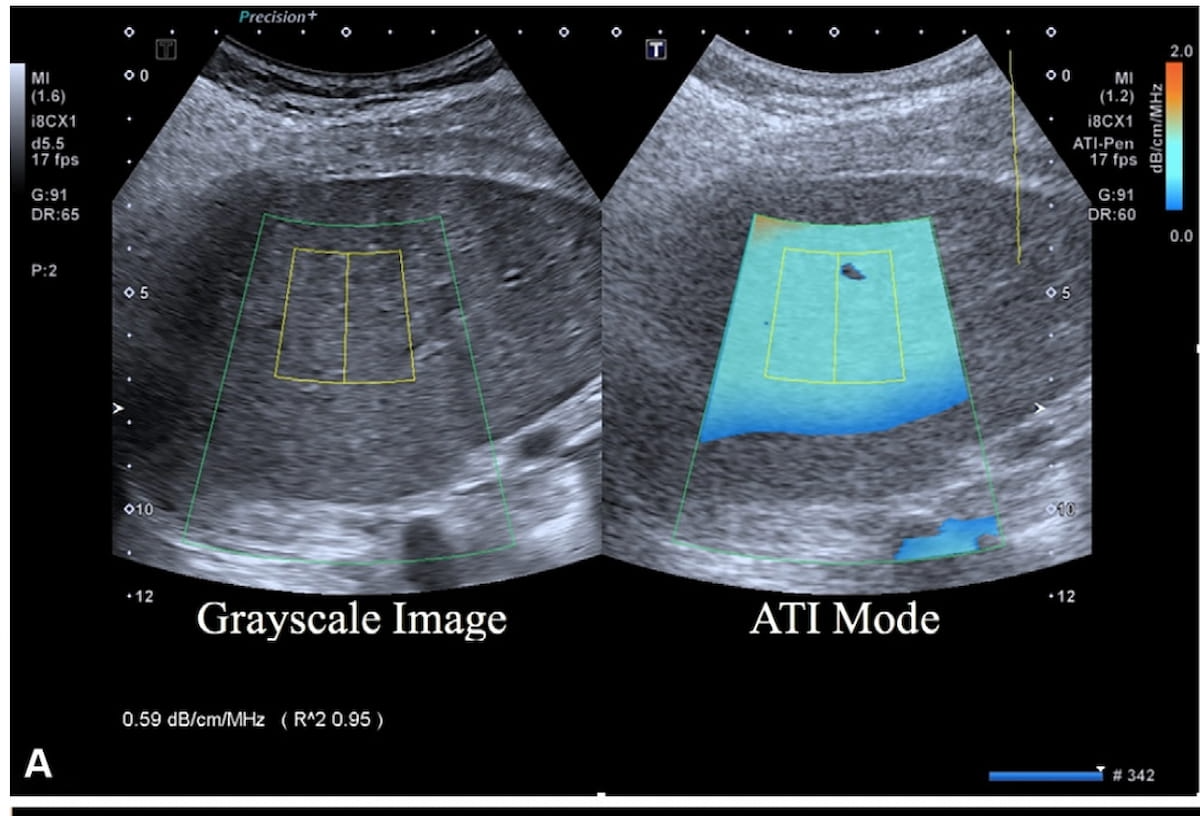The use of attenuation imaging in a multiparametric ultrasound model may facilitate improved diagnosis of metabolic dysfunction-associated steatohepatitis (MASH) in patients with metabolic dysfunction-associated fatty liver disease (MAFLD).
For a multicenter prospective study, recently published in Radiology, researchers evaluated data (including findings from multiparametric ultrasound) for 424 study participants (median age of 47) with MAFLD drawn from 12 tertiary hospitals. Seventy-eight percent of the cohort had MASH. The study authors also noted that 28.5 percent of the cohort had hepatitis B and 29.7 percent had diabetes mellitus. All study participants had attenuation imaging (ATI), two-dimensional shearwave elastography (SWE) and biochemical testing prior to a liver biopsy, according to the study.
The researchers found that attenuation coefficient (AC) had a 3.32 odds ratio (OR) for MASH. The study authors noted the international normalized ratio (INR) and an alanine aminotransferase (ALT) level above 40 U/L were also independently associated with MASH (with respective ORs of 0.59 and 4.42) in a multivariable analysis.
A nomogram utilizing AC, ALT and INR demonstrated a 77 percent area under the curve (AUC) in validation testing for the prediction of MASH in comparison to 70 percent for a model that combined ALT and INR, according to the study authors.
“MASH not only correlates with the amount of liver fat but also with other indexes. … According to our results, it is very convenient to use the AC, ALT and IR combination model to predict MASH in the MAFLD population in clinical practice,” wrote lead study author Fangyi Liu, M.D., who is affiliated with the Department of Interventional Ultrasound at the Chinese PLA General Hospital in Beijing, China, and colleagues.
Three Key Takeaways
- Attenuation imaging (AC) is a valuable tool. Attenuation imaging, particularly when combined with other parameters like ALT and INR, shows promise in predicting metabolic dysfunction-associated steatohepatitis (MASH) in patients with metabolic dysfunction-associated fatty liver disease (MAFLD). AC had a high predictive value for MASH with an odds ratio of 3.32.
- Multiparametric ultrasound enhances diagnosis. Multiparametric ultrasound, incorporating AC assessment along with two-dimensional shearwave elastography (SWE), offers enhanced grading of hepatic steatosis, inflammation activity, and fibrosis staging in MAFLD patients. This comprehensive approach showed high sensitivity rates and AUCs for detecting severe steatosis and advanced fibrosis.
- Improved prediction in Hepatitis B subgroup. The combination model of AC, ALT, and INR had a higher predictive ability for MASH in patients with MAFLD, even in those with concomitant hepatitis B infection. This indicates the potential utility of these parameters in a subgroup of patients with additional liver disease burden.
The study authors also found that regardless of whether study participants had the hepatitis B virus, AC assessment with attenuation imaging and SWE assessments of dispersion slope and liver stiffness allowed for enhanced grading of hepatic steatosis and inflammation activity, and fibrosis staging in patients with MAFLD. Specifically, AC assessment had a 90 percent AUC and 91 percent sensitivity rate for detecting grade S3 hepatic steatosis. The study authors also pointed out that SWE had a 94 percent AUC and 97 percent sensitivity for F4 staging of liver stiffness.
In subgroup analysis, the study authors noted that the combination model of AC, ALT and INR had an 82 percent AUC for MASH prediction for those with hepatitis B and a 79 percent AUC in participants without hepatitis B.
Noting the significantly elevated risk of hepatocellular carcinoma in people with NAFLD and hepatitis B, Liu and colleagues emphasized that “ … the evaluation of patients with MAFLD and concomitant hepatitis B virus infection is crucial.”
In an accompanying editorial, Karen L. Reuter, M.D., FACR, FAAWR, noted challenges with MRI costs, accessibility issues with chemical shift-encoded MRI and limitations with conventional ultrasound in diagnosing MASH. Emphasizing the importance of diagnosing steatosis in treating early liver disease, Dr. Reuter said the current study’s findings are promising.
“The predictive model combining attenuation coefficient, alanine aminotransferase level, and international normalized ratio showed good discrimination ability for predicting MASH in MAFLD,” noted Dr. Reuter, a professor of radiology at Tufts University School of Medicine in Boston, and a past president of the American Association for Women Radiologists.
(Editor’s note: For related content, see “Large MRI Study Links High Proton Density Fat Fraction to Elevated Liver Disease Risks,” “Can Deep Learning Enhance Ultrasound Assessment of Hepatic Steatosis in Patients with NAFLD?” and “Multi-Parametric CT Offers Earlier Detection for Common Liver Disease.”)
In regard to study limitations, the researchers acknowledged the possibility of multiple etiologies for patients with MAFLD and that hepatitis B was the only etiology assessed in the study. With the cohort entirely comprised of Chinese patients, extrapolation of the study findings to a broader population may be limited, according to the study authors. The researchers added that prospective consecutive enrollment of study participants precluded having the same participant numbers for assessments of various pathologic grades.

